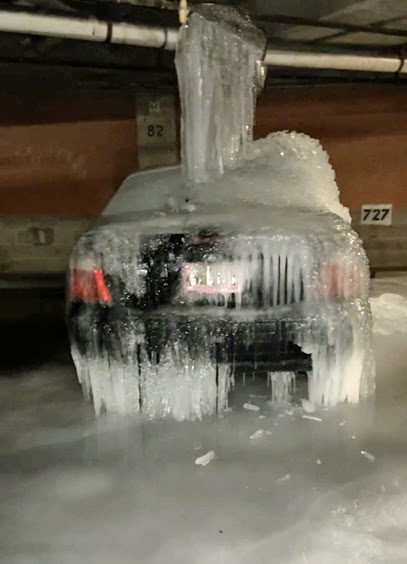Texas storm a wake up call for a worst case climate disaster?
Car frozen in a Texas garage from a broken water pipe
By Michael Coppola
and Nancy Williams
Will the recent winter storm in Texas be the wake up call to do what needs to be done to put the brakes on climate change?
One might be naturally perplexed that with a warming planet that southern locations are getting colder winters and not warmer winters. Some understanding of the Earth’s weather patterns will help. Our weather is driven by the difference in temperature and density of air masses in adjacent areas. The polar vortex is a band of very cold air that normally rotates around the North Pole and stays far north. The jet stream flows well south of the polar vortex and brings warm air from the tropics to the mid-latitudes making locations in the higher mid-latitudes warmer, such as Great Britain which has much milder temperatures than it would have for its latitude.
Records show that the Arctic is warming faster than the rest of the planet; three to six times faster in fact. That means there is now a smaller difference between the two regions. This has resulted in a destabilization of the path of the polar vortex allowing it to move further south and bring cold air to areas that rarely ever see these low temperatures. These effects also cause a pattern change in the jet stream making it buckle. Where the stream buckles north it brings warmer air further north. This causes hotter summers as well as warmer winters in some areas. Where it buckles south it allows colder air from the polar vortex to go even further south bringing unusually cold weather to places like Texas.
The conditions in the Arctic are critical to the overall weather and climate of the planet. The reality is, so much warming has already occurred in the Arctic that these weather patterns will continue to happen. Preparations will need to be done to deal with the consequences of these weather events such as winterization of generating stations in the south and flood barriers along the coasts. Extreme weather events will only get worse and more frequent if we do not take significant steps to stop the warming of the planet.
In the early 2000’s climate scientists presented three possible conditions that would result from increasing amounts of greenhouse gasses. They ranged from least severe if we took significant steps to reduce the amount of greenhouse gas emissions, to most severe if we continued on our present course. They are now saying the most likely case we will reach is somewhere between the most severe and the middle range. We have around eight years left to prevent that worst case from becoming reality.
As we have said several times before we must reduce our energy usage through conservation. Meat consumption plays a role in adding methane, a very potent greenhouse gas, so greatly reducing animal agriculture will help. We can capture carbon dioxide by planting trees and reflect back solar radiation by painting dark surfaces white. All these efforts will help put the brakes on the growing global warming crisis.
References
Are We Headed Toward the Worst-Case Climate Change Scenario? - Pacific Standard (psmag.com)
Climate change: Worst emissions scenario 'exceedingly unlikely' - BBC News
This worst-case climate scenario might be the most realistic | Popular Science (popsci.com)




Comments
Post a Comment